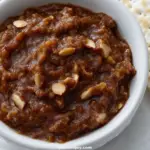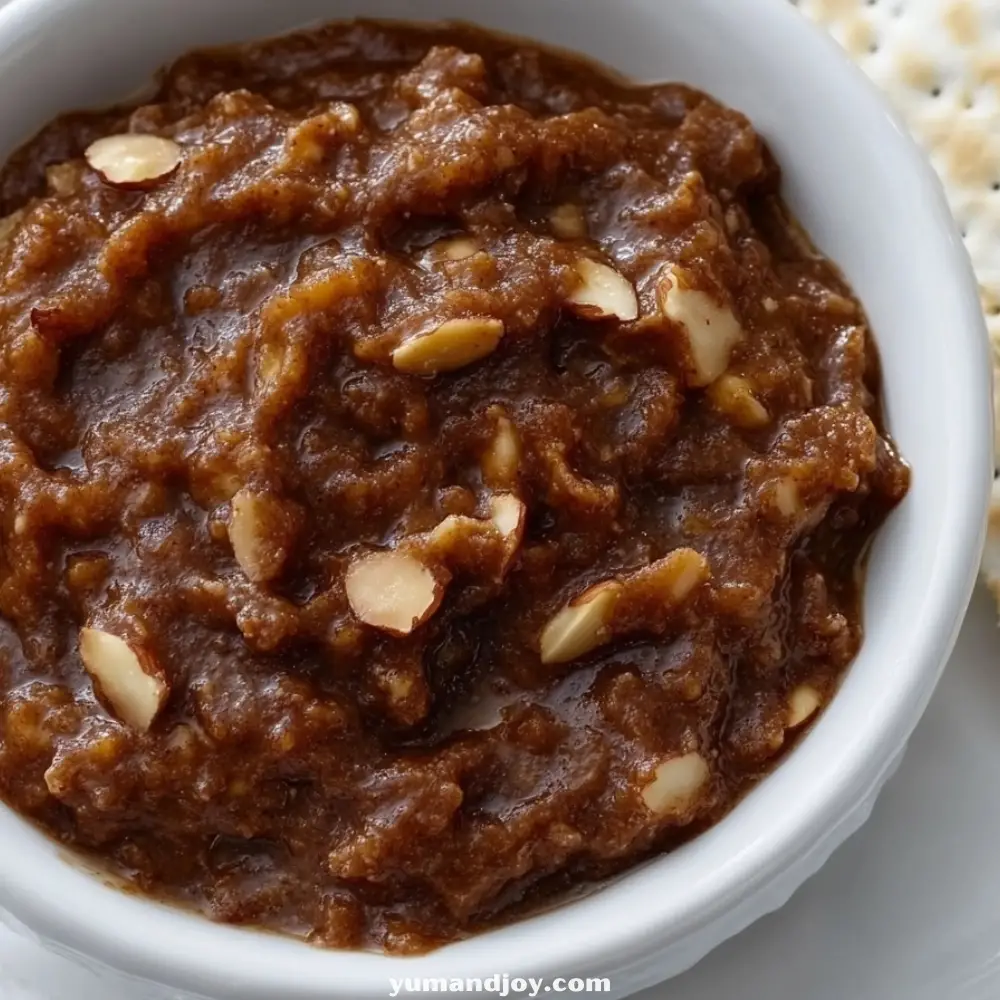Celebrate tradition with a rich twist by preparing Yemenite Charoset, a sweet and spiced fruit spread that’s as symbolic as it is delicious. A staple of Passover tables in Yemenite Jewish communities, this version of charoset blends dried fruits, warm spices, and toasted nuts into a thick, fragrant paste. Whether you’re honoring Passover, adding diversity to your National Tartan Day table, or simply exploring global culinary heritage, Yemenite Charoset offers an earthy, spiced sweetness unlike any other.
Why You’ll Love This Recipe
This Yemenite Charoset is both versatile and deeply flavorful. It delivers the perfect harmony of sweet dried fruit, bold cinnamon, zingy ginger, and nutty texture from toasted almonds. With red wine or apple juice adding depth and moisture, the result is a luscious, spreadable paste that complements matzo beautifully. It’s naturally gluten-free, easy to prepare, and keeps well—making it a meaningful and practical addition to your holiday table.
ingredients
(Tip: You can find the complete list of ingredients and their measurements in the recipe card below.)
1 cup dried pitted dates
1 cup dried apricots
1 cup dried black figs
1/2 cup coarsely ground toasted almonds
1 tsp fresh grated ginger
1 tbsp ground cinnamon
1/4 cup honey
2 cups red wine or apple juice
directions
- In a small saucepan, combine the dried dates, apricots, and black figs with red wine or apple juice.
- Set over medium-low heat and bring to a gentle simmer. Cook for 10–12 minutes, or until the fruit is soft and plump.
- Remove from the heat and allow the mixture to cool slightly.
- Transfer the softened fruit and liquid to a food processor.
- Add grated fresh ginger, ground cinnamon, and honey. Pulse until the mixture is blended but still retains some texture.
- Stir in the coarsely ground toasted almonds for added body and flavor.
- Transfer to a serving bowl. Serve at room temperature or chilled with matzo, or include it as part of a Seder plate.
- Store leftovers in an airtight container in the refrigerator for up to 5 days.
Servings and timing
Prep Time: 10 minutes
Cooking Time: 10 minutes
Total Time: 20 minutes
Servings: 10 servings
Calories: 145 kcal per serving
Variations
- Nut-Free Version: Omit the almonds or substitute with sunflower seeds for a nut-free option.
- Apple-Based Twist: Add 1/2 cup of grated apple for added freshness and a lighter texture.
- Spice Variations: Try adding a pinch of cardamom or ground cloves for a deeper spice profile.
- Wine-Free Option: Use only apple juice for a non-alcoholic version that’s family-friendly.
- Smoother Paste: Blend longer for a smoother, more uniform texture that’s easier to spread.
storage/reheating
Yemenite Charoset stores well and is best served at room temperature or chilled. Keep it in an airtight container in the refrigerator for up to 5 days. Stir before serving, as natural separation may occur. This dish is not typically reheated and does not freeze well due to its moisture content and texture.
FAQs
What is charoset?
Charoset is a traditional Passover dish representing the mortar used by Hebrew slaves in Egypt. It’s made with fruit, nuts, spices, and wine or juice.
How is Yemenite Charoset different from Ashkenazi versions?
Yemenite Charoset uses dried fruits and bold spices, forming a thick paste, while Ashkenazi charoset often includes fresh apples and a looser consistency.
Can I make this ahead of time?
Yes, it can be prepared several days in advance and stored in the refrigerator until ready to serve.
Is Yemenite Charoset served warm or cold?
It is typically served at room temperature or cold, depending on preference.
What can I serve with charoset besides matzo?
Try serving it with oatcakes, crackers, or even spread on toasted challah for a unique snack.
Can I use a blender instead of a food processor?
Yes, but pulse in short bursts to avoid over-blending and losing the desired texture.
What kind of wine should I use?
A dry or semi-sweet red wine works best. Avoid wines that are too sweet, as the fruit already provides ample sugar.
Can I use other dried fruits?
Yes, prunes, golden raisins, or dried cherries can be substituted or added to diversify flavor.
Is this dish kosher for Passover?
Yes, as long as all ingredients are certified kosher for Passover, especially the wine or juice.
Can children eat this version with wine?
If using wine, simmering reduces most of the alcohol, but for safety and preference, apple juice is recommended for a kid-friendly version.
Conclusion
Yemenite Charoset is a vibrant and meaningful dish that embodies the rich culinary traditions of the Jewish diaspora. With its deep flavors, sweet warmth, and cultural symbolism, it brings both history and hospitality to your Passover or multicultural table. Whether enjoyed with matzo or as part of a festive spread, this spiced fruit paste is a beautiful tribute to shared heritage and communal celebration.
Print
Yemenite Charoset
- Total Time: 20 minutes
- Yield: 10 servings
- Diet: Gluten Free
Description
Add bold flavor and multicultural flair to your Passover table or National Tartan Day celebration with this Yemenite Charoset. Made with tender dried dates, figs, and apricots, warm cinnamon, fresh ginger, and toasty almonds, all simmered in red wine or apple juice, this spreadable, sweet-and-spiced fruit paste is a beautiful blend of tradition, texture, and taste.
Ingredients
-
1 cup dried pitted dates
-
1 cup dried apricots
-
1 cup dried black figs
-
1/2 cup coarsely ground toasted almonds
-
1 tsp freshly grated ginger
-
1 tbsp ground cinnamon
-
1/4 cup honey
-
2 cups red wine or apple juice
Instructions
-
In a small saucepan, combine dates, apricots, figs, and red wine or apple juice.
-
Bring to a gentle simmer over medium-low heat. Cook for 10–12 minutes, until fruit is soft and plump.
-
Remove from heat and let the mixture cool slightly.
-
Transfer to a food processor. Add ginger, cinnamon, and honey.
-
Pulse until well blended but still slightly chunky for texture.
-
Stir in ground toasted almonds for added richness and crunch.
-
Serve at room temperature in a small bowl with matzo, or include on a Seder plate.
Notes
Store in an airtight container in the fridge for up to 5 days. For a non-alcoholic version, use apple juice instead of wine. Adjust spice and sweetness to taste for your preferred balance.
- Prep Time: 10 minutes
- Cook Time: 10 minutes
- Category: Dessert, Spread
- Method: Simmering, Blending
- Cuisine: Yemenite, Jewish, Middle Eastern


